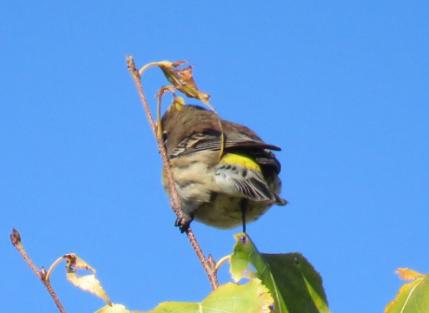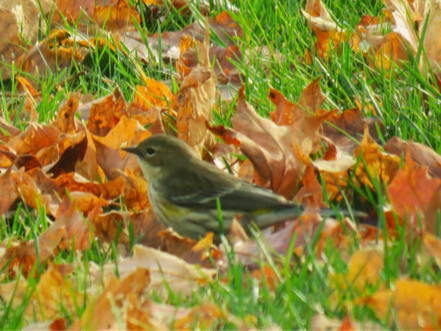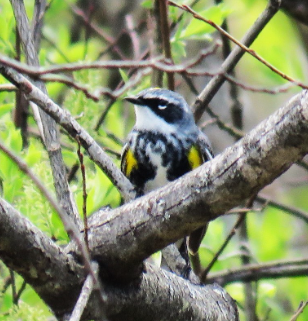Phenological Phacts and Photos w/ Carl Martland / May 2023
Thrice Willing Warbler
Phenology – “a branch of science concerned with the relationship between climate and periodic biological phenomena (as the migration of birds or the flowering and fruiting of plants).”
What’s in a Name?
The warbler shown in the above photo, which is one of the most widely distributed warblers in North America, was once known as the Myrtle Warbler. That name referred to its ability to eat the hard waxy fruits of crepe myrtle trees, giving these warblers a reliable food source for starting their northward migration. When they get to New England, they won’t find any crepe myrtle trees, but they will be able to eat similar fruits of the bayberry bushes found along the coast (fruits that we thought were useful only for making candles!). Fortunately for its ability to enjoy its meals, its diet may be better once it reaches the tall spruces where it will spend the summer, as its Latin name setophagus coronata translates to something like “crowned moth-eater.”
Myrtle warblers were once thought to be eastern cousins of the Audubon warblers found mostly in the western US. However, observers discovered that the Myrtle and Audubon warblers interbreed where their ranges overlap, so scientists decided to classify them as varieties of a single species. Well, fine and good; let the scientists do their job. If two supposedly distinct species interbreed, then they cannot be separate species.
1 Photos and text by Carl D. Martland, founding member of ACT, long-time resident of Sugar Hill, and author of Sugar Hill Days: What’s Happening in the Fields, Wetlands, and Forests of a Small New Hampshire Town on the Western Edge of the White Mountain. Quotations from his book and his journals indicate the dates of and the situations depicted in the photos.
But who decided that “yellow-rumped warbler” would be their new name? I admit that the yellow rump is diagnostic, but the photographs suggest that yellow-winged, white-throated, or black-masked warbler would have been nearly as descriptive and much more appropriate in polite company.
May 9, 2015. The bird formerly known as the “Myrtle Warbler” shows off its fine yellow wings, white throat, and black mask.
Unfortunately, I must admit that I quite like names that help me identify birds that fly into the yard. All warblers are small and flighty, and quite a few have black & white stripes broken up here and there with bits of yellow, but only the Myrtle and Audubon warblers have the yellow rump. That much I can remember, and that is the only sure way that I can identify a yellow-rumped warbler without using a guidebook. For example, the above photo shows an extraordinarily beautiful bird, but only a close comparison to the pictures in the guidebook convinced me that it was indeed a yellow-rumped warbler. On the other hand, as soon as I managed to take the photo below, I knew that I was looking at a yellow-rumped warbler, albeit from a rather embarrassing perspective.
October 5, 2016. Is this how a bird wants to be remembered? Probably not, but this is the view that confirms that it is a yellow-rumped warbler.
Females and juveniles are always less colorful than the males that we see during the spring migration, so the butt photo is even more necessary to identify these warblers in the fall.
October 19, 2020. I took several pictures and a video of a yellow-rumped warbler foraging in the leaves on the front lawn. When it poked its head down into the grass, its wings rose up, clearly exposing the yellow rump that is barely visible in this photo.
Thrice Willing Warbler
In May, birdwatchers in New England look forward to the spring migration of warblers. In Boston, they – the birdwatchers and the warblers – flock to places like Mount Auburn Cemetery. The warblers flit about high in the trees, while the birdwatchers crane their necks as they scan the emerging foliage hoping for a glimpse through their binoculars of the birds that they can hear singing. Serious birdwatchers can identify the species just by hearing the song, and they seem to be happy just to hear the music and capture a few glimpses of the birds.
The other day, my neighbor Rebecca Brown said that she had heard two types of warblers singing in the woods by the beginning of May: black-throated greens and black-throated blues. I probably will hear one or both of them if I spend some time in the woods, but I certainly don’t expect to see any of them. Why not? Because I haven’t seen either of these two species more than a few times in 25 years in Sugar Hill. Although they are willing to stop by on their way to Canada, they usually stay hidden high in the trees.
Yellow-rumped warblers are not only willing to stop by, they are willing to be seen, and they are willing to pose for the photographer. I have frequently seen them amidst a tangle of branches in a clump of alders, willows, or birches. If I stay still, they may stay in one place long enough to get a photo, possibly even one where the bird is only partially obscured by the branches.
May 12, 2017. A yellow-rumped warbler landed in the hedge and stayed there long enough for me to take a photo.
What is unusual about yellow-rumped warblers is that they also will perch in the open, perhaps on some cattails by the pond, on a roof, or on the lawn. Look for them through mid-May, but don’t expect to see them in the summer. By the end of May, they will be raising their young deep in the spruce/fir forests of Canada, and they won’t be back around here until late summer.
May 4, 2019. A yellow-rumped warbler perched on the cattails at the edge of the pond, and it stayed there long enough for me to take this photo.
Final Note
Before checking this little essay for the usual errors in spelling, punctuation, or grammar, I discovered that I may actually have learned something from my literary efforts:
May 5, 2023. A warbler rustled about in the willow clump by the edge of the pond, looking exactly like one of the photos I had just included in my most recent PPP draft. If I hadn’t just pontificated on the yellow-rumped warbler’s beautiful colors, I never would have imagined that I was looking at one of these poorly named birds.





